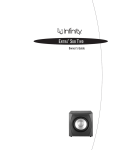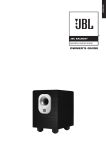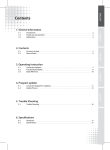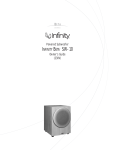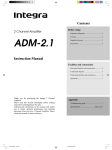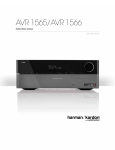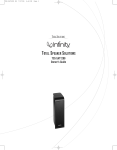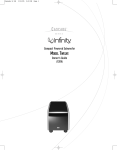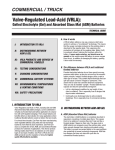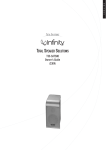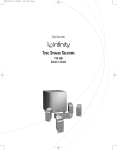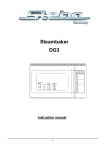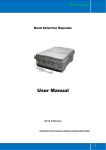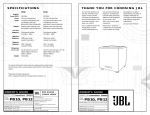Download Powered Subwoofer (120V) Owner`s Manual
Transcript
Powered Subwoofer PS38 (120V) Owner’s Manual IMPORTANT SAFETY PRECAUTIONS Read First! 12. Use only with the cart, stand, tripod, bracket or table specified by the manufacturer or sold with the apparatus. When a cart is used, use caution when moving the cart/ apparatus combination to avoid injury from tip-over. 13. Unplug this apparatus during lightning storms or when unused for long periods of time. 14. Refer all servicing to qualified service personnel. Servicing is required when the apparatus has been damaged in any way, such as power-supply cord or plug is damaged, liquid has been spilled or objects have fallen into the apparatus, the apparatus has been exposed to rain or moisture, does not operate normally, or has been dropped. 1. Read these instructions. 2. Keep these instructions. 3. Heed all warnings. 4. Follow all instructions. 5. Do not use this apparatus near water. 6. Clean only with a dry cloth. 7. Do not block any ventilation openings. Install in accordance with the manufacturer’s instructions. 8. Do not install near any heat sources such as radiators, heat registers, stoves or other apparatus (including amplifiers) that produce heat. 9. Do not defeat the safety purpose of the polarized or grounding-type plug. A polarized plug has two blades with one wider than the other. A grounding-type plug has two blades and a third grounding prong.The wide blade or the third prong is provided for your safety. If the provided plug does not fit into your outlet, consult an electrician for replacement of the obsolete outlet. 10. Protect the power cord from being walked on or pinched, particularly at plugs, convenience receptacles and the point where they exit from the apparatus. 11. Only use attachments/accessories specified by the manufacturer. 2 PS38 (120V) 18. An outside antenna system should not be located in the vicinity of overhead power lines or other electric light or power circuits, or where it can fall into such power lines or circuits. When installing an outside antenna system, extreme care should be taken to keep from touching such power lines or circuits, as contact with them might be fatal. 19. Do not overload wall outlets, extension cords, or integral convenience receptacles, as this can result in a risk of fire or electric shock. 20. Never push objects of any kind into this product through openings, as they may touch dangerous oltage points or short-out parts that could result in a fire or electric shock. Never spill liquid of any kind on the product. 15. Do not use attachments not recommended by the product manufacturer, as they may cause hazards. 21. The apparatus shall not be exposed to dripping or splashing, and no objects filled with liquids, such as vases, shall be placed on the apparatus. 16. This product should be operated only from the type of power source indicated on the marking label. If you are not sure of the type of power supply to your home, consult your product dealer or local power company. For products intended to operate from battery power, or other sources, refer to the operating instructions. 22. Do not attempt to service this product yourself, as opening or removing covers may expose you to dangerous voltage or other hazards. Refer all servicing to qualified service personnel. 17. If an outside antenna or cable system is connected to the product, be sure the antenna or cable system is grounded so as to provide some protection against voltage surges and built-up static charges. Article 810 of the National Electrical Code, ANSI/NFPA 70, provides information with regard to proper grounding of the mast and supporting structure, grounding of the lead-in wire to an antenna discharge unit, size of grounding conductors, location of antenna-discharge unit, connection to grounding electrodes, and requirements for the grounding electrode. See Figure A. Figure A. Example of Antenna Grounding as per National Electrical Code ANSI/NFPA 70 23. When replacement parts are required, be sure the service technician has used replacement parts specified by the manufacturer or that have the same characteristics as the original part. Unauthorized substitutions may result in fire, electric shock or other hazards. 24. Upon completion of any service or repairs to this product, ask the service technician to perform safety checks to determine that the product is in proper operating condition. 25. The product should be mounted to a wall or ceiling only as recommended by the manufacturer. INTRODUCTION Infinity® PS38 Powered Subwoofer The Infinity® PS38 powered subwoofer continues the longstanding Infinity commitment to accurate sound reproduction. Our proprietary technology and engineering resources work together to deliver uncompromised lowfrequency performance in any stereo or multichannel home theater system. Unpacking the Subwoofer If you suspect damage from transit, report it immediately to your dealer. Keep the shipping carton and packing materials for future use. PLACEMENT Since installing a subwoofer can be somewhat more complicated than installing full-range speakers, read this section very carefully prior to connecting the subwoofer to your system. Should you have questions relating to your installation, call your dealer or visit www.infinitysystems.com for assistance. The performance of the subwoofer is directly related to its placement in the listening room and how you align the subwoofer with its satellite speakers. Most audio authorities believe that low frequencies (below 125Hz) are nondirectional, and, therefore, the location of a subwoofer within any listening room is not critical; but within the limited confines of a room, reflections, standing waves and absorptions generated within the room will strongly influence the performance of any subwoofer system. As a result, the specific location of the subwoofer becomes important, and we strongly recommend that you experiment with placement before choosing a final location. Placement will depend upon the amount and quality of bass required and upon your room (for example, whether or not your room permits placement of the subwoofer near either satellite). Be sure to leave a minimum of 15cm (nearly six inches) between the wall and the port on the subwoofer. Subwoofer Rightchannel speaker Leftchannel speaker Primary listening area Figure 1. This example shows the subwoofer positioned behind the rightchannel satellite speaker to re-create the actual location of bass instruments in an orchestra and/or to add impact to movie soundtracks. Setting the volume of the subwoofer in relationship to the left and right speakers is also of critical importance because it is essential that the subwoofer integrate smoothly with the entire system. Setting the subwoofer’s volume level too high will result in overpowering, boomy bass. Setting the volume level too low will negate the benefits of the subwoofer. PS38 (120V) 3 CONTROLS AND CONNECTIONS Rear Panel ¡ Subwoofer Level Control ™ Crossover Adjustment Control ¡ £ Phase Switch ¢ LFE Input ™ ∞ Line-Level Inputs § Power Switch £ ¢ ∞ § FUSE T 2.5A L 250V TYPE 4 PS38 (120V) AC~ 120V 60HZ 200 Watts SYSTEM CONNECTIONS Choose the Subwoofer Connection that is Most Suitable for Your Receiver/Processor If you have a Dolby® Digital or DTS® receiver/processor with a lowfrequency effects (LFE) or subwoofer output: SUBWOOFER OR LFE OUTPUT If your receiver/processor does not contain a Dolby Digital or DTS processor but has subwoofer outputs: Receiver/Processor SUB OUT L R NOTE: Some receivers have one subwoofer output. In that case, we recommend that you use a Y connector (not included) to maximize performance. PS38 (120V) 5 OPERATION Crossover Adjustment Power On The Crossover Adjustment Control ™ determines the highest frequency at which the subwoofer reproduces sounds. If your main speakers can comfortably reproduce some low-frequency sounds, set this control to a lower frequency setting, between 50Hz and 100Hz. This setting will concentrate the subwoofer’s efforts on the ultradeep bass sounds required by today’s films and music. If you are using smaller bookshelf speakers that do not extend to the lower bass frequencies, set the Crossover Adjustment Control to a higher setting, between 120Hz and 150Hz. Plug your subwoofer’s AC cord into a wall outlet. Do not use the outlets on the back of the receiver. Initially set the Subwoofer Level Control ¡ to the “Min” position. Turn on your subwoofer by pressing the Power Switch §. Turn on your entire audio system and start playing a CD or movie soundtrack at a moderate level. Auto On/Standby With the Power Switch § in the ON position, the Status LED Light will remain lit in red or green to indicate the On/Standby mode of the subwoofer. RED = STANDBY (No signal detected, amp off) GREEN = ON (Signal detected, amp on) The subwoofer will automatically enter the Standby mode if it detects no signal from your system for about 10 minutes. When it detects a signal, the subwoofer will power on instantly. During periods of normal use, you can leave the Power Switch § on. You may turn off the Power Switch § for extended periods of nonoperation, e.g., when you are away on vacation. Adjust Gain Turn your Subwoofer Level Control ¡ up to the halfway position. If no sound emanates from the subwoofer, check the AC-power cord and input cables. Are the connectors on the cables making proper contact? Is the AC plug connected to a “live”receptacle? Has the Power Switch § been pressed to the “On”position? Once you have confirmed that the subwoofer is active, proceed by playing a CD, record or cassette. Use a selection that has ample bass. Set the overall volume control of the preamplifier or stereo to a comfortable level. Adjust the Subwoofer Level Control ¡ until you obtain a pleasing blend of bass. Bass response should not overpower the room but rather be adjusted so there is a harmonious blend across the entire musical range. Many users have a tendency to set the subwoofer volume too loud, adhering to the belief that a subwoofer is there to produce lots of bass. This belief is not entirely true. A subwoofer is there to enhance bass, extending the response of the entire system so listeners can feel the bass as well as hear it. However, the system must maintain an overall balance, or the music will not sound natural. An experienced listener will set the volume of the subwoofer so its impact on bass response is always there but is never obtrusive. Phase Control The Phase Switch £ determines whether the subwoofer speaker’s piston-like action moves in and out with the main speakers (0°) or opposite the main speakers (180°). Proper phase adjustment depends on variables such as room size, subwoofer placement and listener position. Adjust the phase switch to maximize bass output at the listening position. 6 PS38 (120V) NOTE: This control will have no effect if the LFE/Normal Selector ¢ is set to LFE. If you have a Dolby Digital or DTS processor/receiver, it will set the low-pass frequency. Consult your owner’s manual to learn how to view or change this setting. MAINTENANCE AND SERVICE You may clean the enclosure using a soft cloth to remove fingerprints or to wipe off dust. The grille may be gently vacuumed. You may remove stains with an aerosol cleaner; follow its instructions. Do not use any solvents on the grille. All wiring connections should be inspected and cleaned or remade periodically. The frequency of maintenance depends on atmospheric conditions, the metals involved in the connections and other factors, but once per year is the minimum. If your subwoofer ever needs service, contact your local Infinity dealer or distributor, or visit www.infinitysystems.com to find a service center near you. SPECIFICATIONS PS38 Frequency response: 35Hz – 150Hz (±3dB) Maximum amplifier output: 150 watts RMS 300 watts peak Crossover frequency: 50Hz – 150Hz, 24dB/octave, continuously variable Driver: 8" (200mm) MMD® transducer Dimensions (H x W x D): (with grille) 17-7/8" x 10-5/8" x 16-1/2" (454mm x 270mm x 419mm) Weight: 31.7 lb (14.4kg) (20Hz – 150Hz with no more than 0.1% THD) Infinity engineers continually strive to update and improve existing products as well as to create new ones. The specifications and construction details in this and related Infinity publications are therefore subject to change without notice. PS38 (120V) 7 Harman Consumer, Inc. 8500 Balboa Blvd., Northridge, CA 91329 USA © 2010 Harman International Industries, Incorporated. All rights reserved. Infinity and MMD are trademarks of Harman International Industries, Incorporated, registered in the United States and/or other countries. Dolby is a registered trademark of Dolby Laboratories. DTS is a registered trademark of DTS, Inc. Features, specifications and appearance are subject to change without notice. Part No. 950-0304-001 6/10 www.infinitysystems.com










